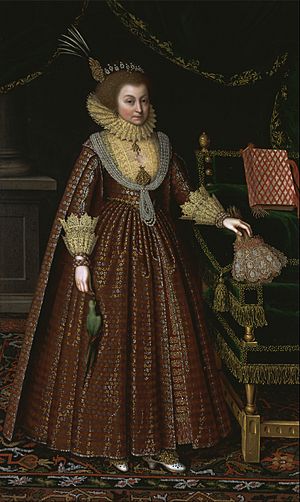Arnold Lulls facts for kids
Arnold Lulls was a skilled goldsmith and jeweller who lived in London between about 1580 and 1625. He was originally from Antwerp, a city in what is now Belgium. Arnold Lulls worked for the royal court in England, creating beautiful jewellery. Many of his pieces were given as special gifts to important people from other countries.
Working as a Jeweller
Arnold Lulls moved to London before 1585. He became an official resident of England in 1618. He also worked with his brothers, Peter and Hans Lulls, to bring goods into the country. In 1597, they had a problem when their ship's cargo was taken by the Earl of Cumberland. They complained about this to Sir Robert Cecil, an important government official.
In 1604, Lulls made jewels for the Spanish ambassador. These jewels were given to the ladies-in-waiting of Anne of Denmark, who was the Queen of England. One special jewel, worth about £230, was given to the Countess of Derby.
Lulls often worked with other famous jewellers like John Spilman and William Herrick. Together, they supplied many jewels to the royal family. For example, in 1605, they provided a pearl necklace and a large pearl for Queen Anne. They also made a chain and a St George pendant for Prince Henry. A jewel was made for Prince Charles. Queen Anne also gave two gold lockets with portraits to the French ambassador and his wife.
Between 1604 and 1607, Lulls and Spilman supplied jewels worth over £2,700 to the royal family. Some of these jewels had the Queen's initials "AR" (Anna Regina) and the King's initials "JR" (Jacobus Rex), along with thistles.
Arnold Lulls also created a special jewel for Queen Anne to give to Margaret of Austria, Queen of Spain. This jewel showed symbols of the House of Habsburg, which was a powerful royal family. It had a diamond double eagle and a golden fleece. This gift was presented in Madrid in 1605.
In May 1605, Lulls and another jeweller, Philip Jacobson, were paid for jewels. These jewels, set with diamonds and two dozen buttons, were given to Queen Anne at the baptism of her daughter, Princess Mary.
Lulls' Family Life
Arnold Lulls was married twice. His first wife was Susanna de Beste, who passed away in 1597. Their son, also named Arnold Lulls, died in 1618. He left some money to his "cousin," Jane van Lore.
Arnold Lulls' second wife was the mother of his daughters, Maria (or Mary), Margriet, and Sara Lulls.
His daughter, Susan (or Susannah) Lulls (1597-1654), married John Newdigate in 1621. John was the son of a courtier named Anne Fitton. Sir John Tonstal, another courtier, witnessed their marriage agreement. Margreit Lulls, Susan's sister, visited the Newdigate family home, Arbury Hall, in the 1620s. Arnold Lulls wrote to John and Susannah in 1623 after a sad event involving their second child.
After John Newdigate passed away, Susannah married Simon Edwards in 1646. He was a London merchant. In her will, Susannah left her personal jewellery to her sister Sara Lulls. This included earrings with five diamonds. Her sister Mary Blackwell received a ruby ring, a gold picture of Elizabeth I, and a special amethyst. Mary's husband was Andrew Blackwell, a vicar. The name "John Blackwell" is written in a book of drawings made by Arnold Lulls. This book is now kept at the Victoria and Albert Museum.
The Lulls Album of Drawings

Arnold Lulls is connected to a special album of drawings. This album contains designs for jewels from the 1600s. It is kept at the Victoria and Albert Museum (V&A) in London. The drawings were made by a few different artists.
We know the album is linked to Lulls because of a note written in Dutch. The note says that a jewel was not the right colour and could not be sold. It was to be returned to "my brother Peter Lulls and company," and it was signed "AL" (Arnold Lulls). The album also includes an official document from 1605 for Lulls and Herrick.
These kinds of drawings were important for several reasons. They helped keep records of jewels for inventories. They were also used within the jewellery business, as the Lulls note shows. Rich customers would also ask for drawings when they ordered new jewels. Some drawings in the Lulls album show the gems at their actual size.
A letter to Arthur Bodren, a page to Queen Anne, talks about finding diamonds and rubies of the correct size for a design by a Mr Halle. John Spilman also made drawings of eleven diamonds that Queen Anne pawned in 1615.
- Lulls album, page 49 with Dutch note signed "AL"
- Lulls album, design for a feather jewel with emeralds and rubies
- Lulls album, designs for two feather jewels
Feather jewels, also called aigrettes, were very popular in the early 1600s. You can often see them in portraits from that time. Some designs in the Lulls album for these feather jewels might be linked to a portrait by Paul van Somer. This painting is at the Yale Center for British Art and is thought to show Elizabeth, Countess of Kellie.
King James also had a feather jewel with 26 large diamonds and smaller stones. He wore it on his hat. This jewel was shown in several portraits, following a design by John de Critz.

